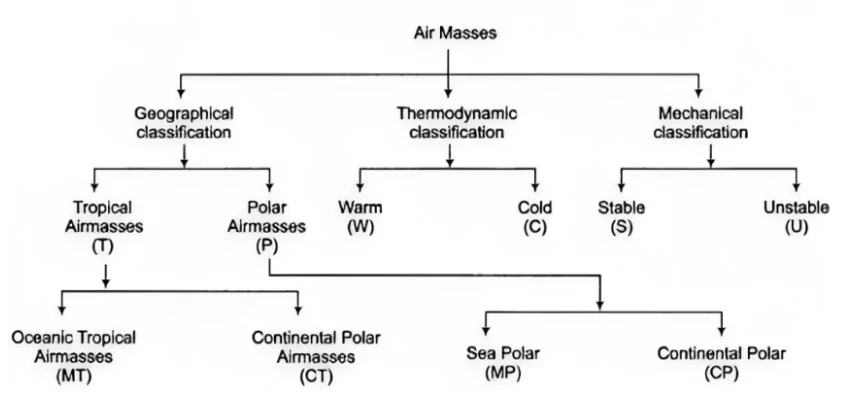Air masses are like big blankets of air that have specific characteristics, such as temperature and humidity, and cover large areas. They form when air stays over one place for a while, like over a hot desert or a cold ocean. There are different types, like cold air masses from polar regions or warm ones from deserts, each bringing its kind of weather. When these air masses meet, they create boundaries called fronts, which can lead to changes in weather, like heavy rain or gentle showers.
Air Masses and Fronts: Origins and Effects

- Definition of Air Mass: A large body of air having distinctive characteristics in terms of temperature and humidity with little horizontal variation.
- Source Region: When air remains over a homogenous area for a sufficiently long time, it acquires the characteristics of the area. These are known as Source Regions.
- It imparts heat and moisture characteristics to the overlying air mass.
- This can be the vast ocean surface or vast plains and plateaus.
- There are no major source regions in the mid-latitudes as these regions are dominated by cyclonic and other disturbances.
Types of Air Mass
- Cold Air Mass: Air Mass which is colder than the underlying surface.
- Example: Air mass over Siberia is not cold for Siberia.
- This air mass might be cold air mass for the warmer regions down south.
- Warm Air Mass: Air Mass which is warmer than the underlying surface.
- Example: Air mass over Siberia might be warm air mass for the Arctic region.
- Air Masses are classified on the basis of source regions as follows:
Enroll now for UPSC Online Course
Classification of Air mass
| Types of Air Masses |
| Air Mass Type |
Source Region |
Characteristics |
| Continental Polar (cP) |
Cold, dry land areas |
Cold and dry, frigid temperatures, low humidity |
| Continental Tropical (cT) |
Hot, desert regions |
Hot and dry, high temperatures, low humidity |
| Maritime Polar (mP) |
Cold oceanic regions |
Cool and moist, cool to cold temperatures, moisture |
| Maritime Tropical (mT) |
Warm oceanic regions |
Warm and humid, warm temperatures, higher humidity |
| Continental Arctic (cA) |
Polar regions |
Extremely cold and very dry, bitterly cold, dry |
| Continental Equatorial (cE) |
Desert regions near the equator |
Extremely hot and dry, scorching temperatures, low humidity |
Fronts
- Definition: Front is a three dimensional boundary zone between two converging air masses with contrasting physical properties like temperature, humidity etc.
- Formation: Commonly formed in the middle and higher latitudes (40°- 65° latitudes) where warm and moist subtropical air masses come in contact with cold and dry polar air masses.
- Frontogenesis: Process of formation of a front is known as Frontogenesis and it involves convergence of two distinct air masses.
- Fronotolysis: Dissipation/ weakening of the front is known as Frontolysis where one of the air masses overrides another.
- In the northern hemisphere, Frontogenesis happens in an anticlockwise direction (clockwise in the southern hemisphere) due to the Coriolis Effect.
- It is the reason for the formation of temperate cyclones in mid-latitudes.
Types of Fronts
Types of Fronts Based on the Mechanism of Frontogenesis
- Stationary Front: Air masses are not moving against each other; Wind motion is parallel to the front.
- Cold Front: Transition zone where an advancing cold dry air mass violently displaces a warm moist air mass; Cold air advances toward warm air; steeper.
- Cumulonimbus clouds are formed resulting in heavy rainfall.
- Example: In the USA, Thunderstorms and tornadoes are common features in warm sectors of a cold front.
- Warm Front: Warm air advances toward cold air and makes a gradual front; less steep.
- Causes moderate to gentle precipitation over a large area
- Occluded Front: When a cold air mass overtakes a warm air mass and goes underneath it. Warm air mass is lifted entirely off the land surface
Conclusion
- Air masses are with specific traits like temperature and humidity, shaped by where they come from, like deserts or oceans. When these air masses meet, they create fronts, which can lead to changes in weather, like heavy rain or gentle showers.
- Understanding these air masses and fronts helps us predict and prepare for different kinds of weather, from thunderstorms to cold snaps.
![]() April 29, 2024
April 29, 2024
![]() 5706
5706
![]() 0
0
